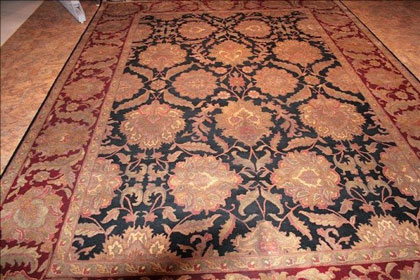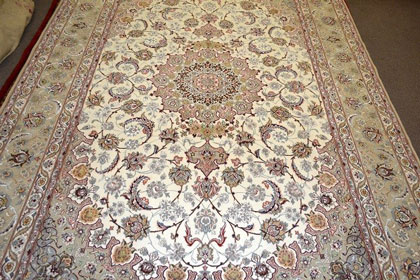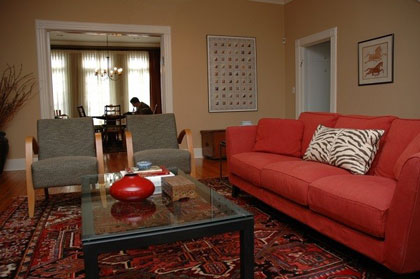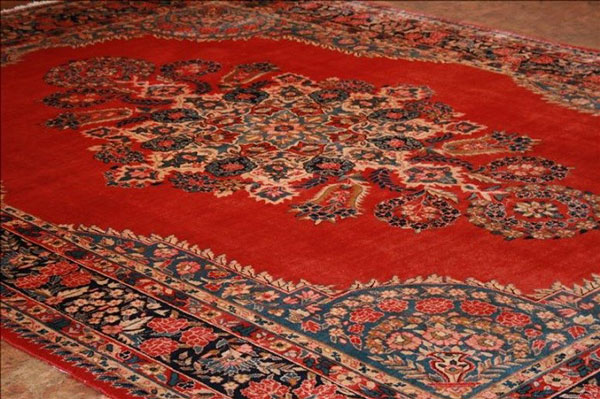Colors of Persian Rugs & Oriental Carpets

One of the appealing aspects of Persian rugs is their warm and soft coloration. The majority of Persian rugs are dyed using plants found locally growing on mountains or farms. The coloration and the combination of colors in Persian rugs and carpets is a key determinant of the value of your rug. There are many factors that you should consider when it comes to coloration:
What is good coloration?
Which colors appeal to someone is a matter of personal taste. We are not here to define the concept of beauty, but different cultures do tend to prefer different colors. For example, the majority of customers in western countries are looking for rugs with lighter backgrounds such as NAIN or a soft KASHMAR. In contrast, rugs and carpets with red-hot backgrounds from KASHAN or TABRIZ still are in very high demand in IRAN.
What type of dye was used to color the wool or cotton?
Chemical dye
(The majority of cheap carpets and rugs are colored with this type of dye because it is low in cost and saves time).
Vegtable dye
(It is hard to find vegetable-dyed carpets these days, but if you look, you can find them among tribal and village rugs in IRAN). The art of coloring is as ancient as human history. Humans used different materials for coloration of their houses and even their bodies. We describe here only the materials and vegetables that have been used for the coloration of wool and cotton in Persian rugs and carpets for centuries.
Source of Rugs & Carpets Coloration
| Colors |
Sources |
| Red |
Root of wild
Madder
|
| Blue |
Indigo Plants |
| Green |
Turmeric Berries |
| Black |
Logwood Plants |
| Khaki |
Nuts or
Tree Bark
|
| Yellow |
Saffron,
Pomegranate
Plant
|
| Salmon |
Depleted
Madder
Dye
|
| Brown |
Tannin,
Oak Tree Galls
, Iron
|
There are more colors that are used in Persian rugs and
carpets. |
How many different colors are used in a rug or carpet?
As the number of colors used increases, expect to pay more for the rug. In some museum quality rugs (made by master weavers) the number of colors reaches as high as 250. It takes years of experience and knowledge to create rugs with such complex coloration.
symbolic meaning of persian carpet colors

Here we share the traditional meanings commonly attributed to the standard colors used in Persian (Oriental) area rugs. Characteristics, ideals and emotions evoked by color change with the times. In carpet lore, common themes emerge from the mists of history and still inform color choices for designs today.
- Red – happiness, joy, beauty, courage, luck
- Green – paradise, sacred, renewal, spring
- Brown – fertility
- Yellow/Gold – power, glory
- Blue: Trustworthy, dependable, and committed
- Orange – devotion, piety, humility
- White – purity, peace, cleanliness
- Black: Restful and mysterious
How to pick a carpet color

There are a few basic steps to follow to find your perfect carpet color.
Functional aspects of carpet color
You want to make your room look bigger
Lighter color carpets tend to make rooms look bigger. A quality many small to midsize homeowners appreciate. On the other hand, if you have rooms that you want to feel more cozy and snug, darker shades of carpet can create this effect.
You want to hide stains
Do you have children, own a rental home, or like to entertain guests frequently? Then carpet stains are a regular headache. So what is the best carpet color to hide stains? If you foresee spilling on the carpet as part of your future, go with a solid dark colored carpet.
You want to hide dirt
You’re probably thinking… Isn’t hiding stains and dirt pretty much the same? In some ways, they are the same. But there is a key difference. Stains are spots on the carpet from spills. Dirt is a brownish dirty appearing carpet from oil buildup. A carpet that is good at repelling stains, isn’t necessarily good at also good at being dirt resistant. So what color do you want if hiding dirt is your main problem? Go with a multicolor or flecked carpet. The natural design of these carpets makes it much less obvious that your carpet is in need of a professional cleaning.
Psychology behind carpet colors
Okay, so how colors make you feel may be a little out there for you. And if it is, feel free to skip this section. But there’s no denying everything around us has a psychological impact. So if nothing else, this should be an interesting read. Who knows? Maybe it will serve as the tie-breaker for your color choice.
- Red is stimulating, but this can be a little vague. What does it stimulate? There seems to not be a direct answer; the emotions red evokes are based on the context. However, studies show that people who see red not only feel stimulated but show physical signs of stimulation with slightly increased heart rate and breathing. Common emotions triggered by red are love, war, and hunger. This makes it great for a master bedroom or dining room.
- Orange is similar to red without the intensity. This creates a warm, energetic, and welcoming vibe. Different shades of orange can have different meanings. It is unusual to see a true orange in carpeting, but it could be a fun color for a child’s room, an entertainment room, or a darker orange may be used in a dining room similarly to red.
- Gold/Yellow is the most cheerful energetic color. It can symbolize extravagance due to its association with money. This could be used in to promote energy and motivation in an office room or to be fun and welcoming in an entertainment room.
- Green is life’s color or the color associated with money. True greens and lighter green symbolize nature, renewal, and health. Darker greens symbolize money and possibly greed, and yellow-greens tend to have negative associations of sickness and jealousy. Use lighter greens and true greens anywhere that you want a natural, refreshing vibe.
- Blue is a solid and soothing color, representative of the sky and sea. It symbolizes loyalty, trust, and wisdom. Opposite to red, it slows the body’s metabolism creating a calming and soothing effect; there is some suggestion that this benefits the mind and body. It is a very well accepted color by males. Use blue in any room where you want to promote relaxation. Avoid it in dining rooms and kitchens–unless of course, you want to suppress your appetite.
- Purple is a mix of red and blue. It symbolizes power, luxury, and wealth. Lighter purples may promote romance and nostalgia, but darker purples can be perceived more negatively with sadness. Purple is great for a girl’s bedroom or a work room where you want to embrace your power or wealth.
- Black is a formal color that suggests power, mystery, and evil. Typically black is associated negatively with “dark” feelings and emptiness. However, if it is pulled off correctly it can create a feel of formal elegance. Be cautious how you use black.
- White is purity. It gives a simple feel of cleanliness and innocence. It is the color of perfection since any imperfections stand out with white. White is a great color for a home if it can be maintained. Keep in mind, it will be tough to clean, and a dirty white carpet loses its pure feel.
- Beige and Gray are neutral colors. They may have some meaning but generally don’t provoke much emotion. They can be interpreted as calming or dull. They are versatile colors that work in any room and with a wide range of wall colors.
What color of carpet goes with gray walls?
Gray gives you freedom. It’s a neutral color that goes with about anything. Lighter gray walls go great with darker colors. Think navy blue, burgundy, and black. Dark gray walls you’ll probably want to “open up” the house some, and choose a lighter colored carpet. Possibly a cream or multi-colored carpet.
What color of carpet goes with beige walls?
Beige will work with bold carpet colors. You can get away with turquoise, light blues, and even pinks. The question is will these colors work with the rest of your home décor? If you want something conservative, take advantage of beige’s wide variety of tones. Choose either a darker or lighter tone of beige to contrast from your walls while still staying neutral. Many multi-colored or patterned carpet will work as well.




